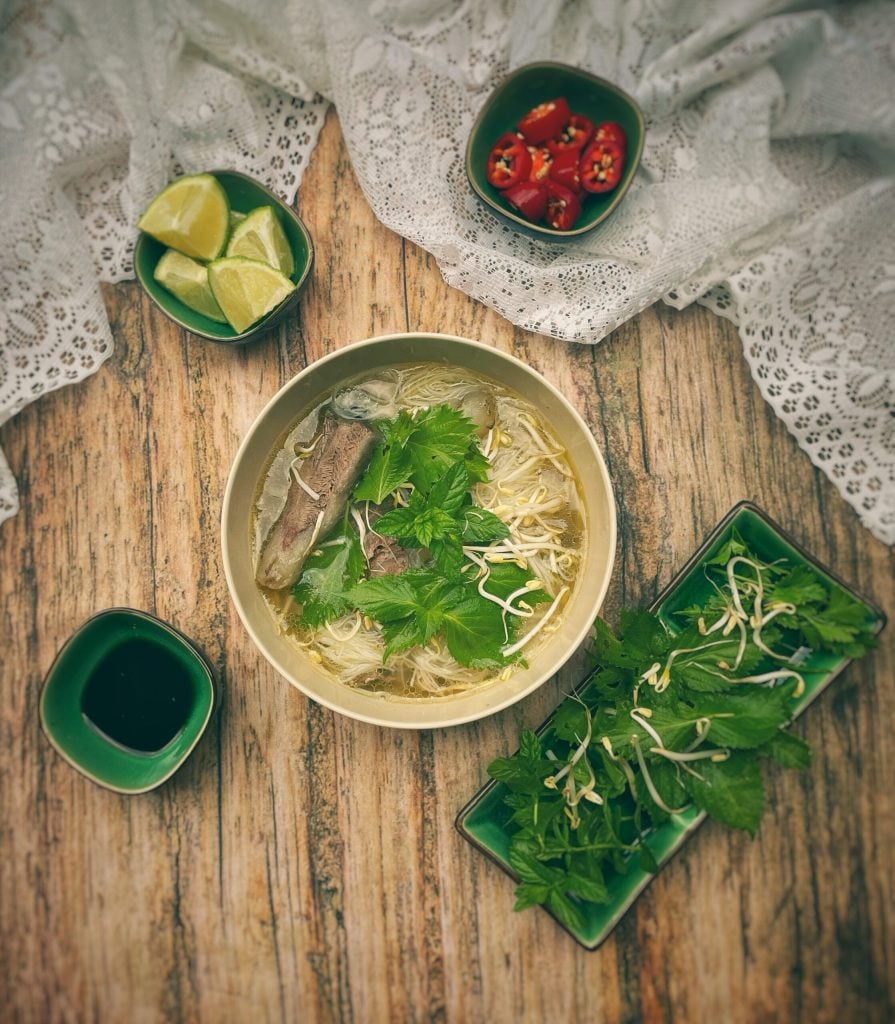The Laotian Pho (ເຝີລາວ) is a traditional variant of the Vietnamese pho, adapted to the local tastes and ingredients of Laos.
The Laotian recipe typically includes a rich broth, infused with aromatic spices like star anise and cinnamon, slow-cooked with beef bones and meat.
The dish is served with rice noodles, fresh herbs (such as cilantro, mint, and Thai basil), bean sprouts, wedges of lime, and sometimes, chili peppers.
Often also called phở Lao or pho Lao, in Laos it is transliterated as “feu” or “fer” in French (due to colonial influence), but the common name remains pho (ເຝີ, pronounced similar to “fuh”).
Although it shares some similarities with the Vietnamese version, it has unique characteristics that set it apart.
The Laotian version tends to have a sweeter and spicier broth, often enriched with palm sugar and a wider variety of spices. Additionally, the addition of fish sauce and the use of local fresh herbs is common.
In Laos, it is common to serve pho with a variety of sauces (such as the fermented fish sauce called padaek) and condiments on the side, allowing each person to customize the flavor according to their taste.

- Difficulty: Easy
- Cost: Economical
- Preparation time: 10 Minutes
- Portions: 4 People
- Cooking methods: Slow cooking
- Cuisine: Asian
- Seasonality: All seasons
Ingredients
- 2.2 lbs beef bones
- 1.1 lbs beef (muscle)
- 1 onion
- 1 fresh ginger (2 inches, sliced)
- 2 sticks cinnamon
- 6 star anise
- 1 tablespoon coriander seeds
- 1 tablespoon fennel seeds
- 2 tablespoons fish sauce
- 1 tablespoon palm sugar
- to taste salt
- to taste bean sprouts
- to taste fresh herbs (cilantro, mint, Thai basil)
- 1 lime
- to taste fresh chilies (sliced)
- to taste Fermented Fish Sauce Padaek
- 1.1 lbs rice noodles (Sen Lek)
Steps
Roast the onion and ginger on a grill or in a pan until slightly charred.
In a large pot, bring the beef bones and meat to a boil in water for about 5 minutes. Drain and rinse the bones and meat to remove impurities.
Refill the pot with clean water (4 liters), add the bones, meat, roasted onion, ginger, and the spices (cinnamon, star anise, coriander seeds, and fennel seeds).
Add the fish sauce, sugar, and salt.
Bring to a boil, then reduce the heat and let it simmer for at least 4 hours, skimming occasionally. The longer it cooks, the more flavorful the broth will be.
Cook the rice noodles according to the package instructions. Drain and rinse with cold water to stop the cooking.
Place the cooked noodles in individual bowls.
Pour the hot broth over the noodles and meat.
Serve with fermented fish sauce, bean sprouts, fresh herbs, and/or fried garlic and/or chilies on the side.
FAQ
What are the differences between Laotian pho and Vietnamese pho?
Sweeter and spicier broth.
Use of fish sauce, palm sugar, and local spices.
Laotian Pho is often served with more herbs and condiments on the side.
The cut of meat can vary, sometimes even including offal.Are there variants of Laotian pho with different names like in Vietnam?
Yes, just like in Vietnam, in Laos and among Laotian communities, there are regional variants of pho (ເຝີ) with slightly different names and ingredients, although less codified compared to Vietnamese tradition.
In Vietnam, for instance, there are:
Phở bò – with beef
Phở gà – with chicken
Phở tái – with raw meat
Phở áp chảo – stir-fried
In Laos, while maintaining the generic name “feu” or “pho”, you might find:
Feu bò – similar to phở bò, broth with beef
Feu gà – with chicken
Feu khua – richer version, sometimes with offal or minced meat
Feu khao poon – a hybrid between pho and fermented noodle soup, less common
However, in Laos the names are not always standardized: the dish usually remains “pho” or “fer”, with the variants described directly on the menu or indicated by the ingredients (e.g., “pho with chicken”).What are the noodles called in Laotian pho?
Noodles used in Laotian pho are generally called:
“Khao Piak Sen” (ເຂົ້າປຽກເສັ້ນ)
but also “Sen Lek” (ເສັ້ນແລກ)
These are flat rice noodles, similar to those in Vietnamese pho.
“Sen” = noodles
“Lek” = thin
(Thus “sen lek” = thin noodles)
In some local variants, sen yai (wide) or other fresh rice noodles are used, depending on the region.

